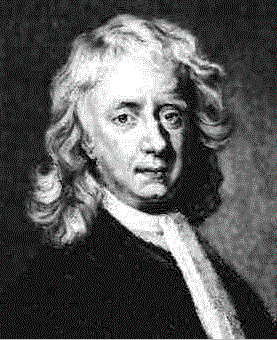Laws of Motion - page 2
*Defining Scalar, Vector, Velocity & Acceleration - online or research activity*
Explain the difference between a vector and a scalar and give an example of each. Define velocity and acceleration and give the formulas for each. Give an example of motion at a constant speed and motion at a constant acceleration. Can you go at a constant speed in a circle? At a constant velocity in a circle? Explain.
ACTIVITIES on Newton's Three Laws of Motion
*Newton's Laws - handout*
Perform these mini activities to demonstrate Newton's Laws of motion.

- online or research activity*
Newton's Laws synthesized those of Kepler and Galileo. First of all, discuss the difference between the physics of Galileo and Aristotle. Explain how Newton's Laws synthesized those of both Kepler and Galileo. If you are using this link - use the next arrows to read the three web pages from Galileo to Newton.
EXTENSION
Demonstrate free fall; in a vacuum with equipment available in the classroom. Write a description of the results.
- online activity (handouts available)
Design your own rockets to illustrate Newton's Third Law of Motion.
*NASA Rocket Actitivies - handouts and project ideas online*

Investigate rocketry principles and Newton's Laws through a multitude of activities. Choose the projects you wish to make and design your own investigations. Write a lab report on your findings.
A virtual lab deriving Newton's second law for students with advanced math ability.
*Atwood's Machine and Newton's 2nd Law - virtual or in-class lab activity*
Another Newton's 2nd law lab for those desiring a more quantitative interpretation. This lab may also be done in class rather than using the online Atwood's Machine simulator using the ULI units on the Macs and a Smart Pulley.
ACTIVITIES on Freefall
*Constant Velocity vs Constant Acceleration - virtual lab activity*
How do displacement vs time and velocity vs time graphs differ for objects moving at constant velocity and constant acceleration? You need a printed copy of this online worksheet.
Take the data and make the graph suggested in this handout. Record the value of the acceleration due to gravity on Earth. Write a short paragraph summarizing your findings.
This lab investigates free fall in more depth. You will need to printout a copy of this handout or get one in the classroom. The link at the top of this sheet is incorrect, use the freefall simulator link below.
ACTIVITIES on Uniform Circular Motion and Centripetal Force
*What Factors Affect Orbital Period? - handout of directions*
Given the Centripetal Force Apparatus, design an experiment to determine how orbital period (the time for one complete orbit) is affected by the mass of the orbiting object, the centripetal force and the orbital radius. The mass of the orbiting object can be changed by using different rubber stoppers, the radius by moving the paper clip, and the centripetal force (the force directed towards the center of the orbit along the radius) by changing the number of washers. Remember, when you are investigating the effects of one factor (e.g. mass) the other two must be kept constant (e.g. centripetal force and radius). Write a formal lab report.
Make a flip book.
ACTIVITIES on Newton's Universal Law of Gravitation

How does weight relate to the acceleration due to gravity? You will need a printout of this worksheet (can get in classroom).
*Newton's Laws of Gravity - online activity
(available as a handout)*
Follow this link for a more in depth discussion. Handouts are available also although the animations will not work, obviously. Answer all review questions.
EXTENSIONS
*Reproduce the calculations that led Newton to believe that the laws of gravity that worked on Earth extended to the moon. You can use the infor you get by clicking on the picture at the right and by following the link under it.
*In Volume I of the Feynman Lecture on Physics, Feynman shows a proof that elliptical orbits come from Newton's Second Law and the Universal law of Gravitation. Follow this proof and create a spread sheet program to show the iterations. Make a chart on the spread sheet using these numbers to show the orbit is elliptical. This activity is for advanced students.
*Describe the Cavendish experiment which determined the value of the constant "G" in Newton's Universal Law of Gravitation.